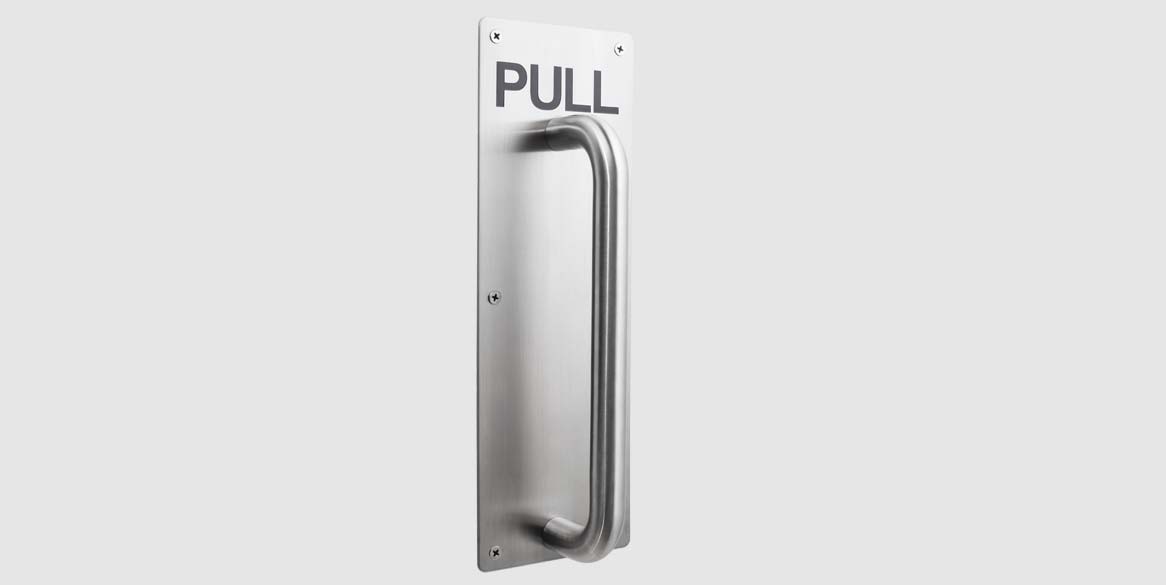


Daniel May, Director at Consort Architectural Hardware, discusses the role door hardware plays in improving hygiene within public building environments.
Health and hygiene are delicate themes, particularly in today’s settings. Both our homes and public building environments can have a huge impact on our wellbeing, and over the past few years, this fact has only been exemplified.
Eighty percent of common infections are spread by touch and every 30 minutes, the average person is said to touch surfaces that expose them to 840,000 germs These germs are prevalent in buildings too, where touchpoints are areas or items that are used by several individuals. Within workplace environments for example, door handles are the most touched surface and can be associated with cross-contamination and health risks.
At present, the need to improve hygiene within our building environments, understandably, carries a greater significance than it maybe once did. But in truth, when it comes to building design, the process of protecting occupants and visitors against infection - especially those most vulnerable - should never be overlooked.

Design for Bacteria Control
Over the past two years, we’ve seen building environments closed, reopened and the process repeated. The idea of reducing footfall in facilities was key in fighting the rising infection rates associated with the coronavirus. But now, that footfall has returned.
Once again, those critical touchpoints such as door handles are harbouring germs. In fact, research has shown that the coronavirus can survive on surfaces for hours, and even days on metal door handles - and the same can be said for the common flu.
In response, we’ve seen government campaigns promoting hand washing, sanitising and distance-making in the wake of a return to public facilities. Undoubtedly, infection control methods such as hand washing and systematic cleaning are the most guaranteed way of controlling cross-contamination - yet, still these methods can become redundant when faced with human error or relaxed conventions within public buildings.
Building design can play an important role here. Daniel May, Director at Consort explains:
“We’re at a point where decision makers are under pressure to keep building hygiene standards as high as ever before. And outside of the clear-cut hygiene measures, it’s understood that more can be done throughout the building design process, with architectural hardware selection at the core of decisions.
“Door hardware is the first touchpoint when entering, exiting or navigating a building, and can be one of the most bacteria-ridden. Yet, the latest in hardware advancements could give facility managers an edge in the fight against infection, especially in healthcare facilities, such as hospitals for example, where footfall is high and the need to maintain strict sterile environments already exists.
“For added protection against bacteria, facilities can implement tailored anti-microbial hardware and finishes. Anti-microbial coatings applied to door handles are precisely formulated to prevent bacteria build-up upon the surface by interrupting cell multiplication. Some door seal solutions also make use of modern anti-bacterial technology, embedding it within the aluminium and silicone of the door seal during production, further reducing the spread of bacteria in high traffic areas.”
The Care Quality Commission (CQC) sets a regulation that cleanliness and effective infection control is a necessity for care and hospital locations. As well as best practice methods, healthcare environments are encouraged to introduce innovative infection control methods where possible. Similarly, under The Workplace (Health, Safety and Welfare) Regulations 1992, Regulations 1992, decision makers have an active duty to keep inhabitants safe and their environments clean. And aside from the use of antimicrobial solutions, many are challenged to provide hygienically maintained environments without sacrificing fire or safety standards.

Daniel adds:
“Facilities with high footfall must also consider ventilation and ease of movement. Whether in healthcare, commercial or public environments, both are key elements of efficient building management and when done effectively, can further help inhibit the spread of infection by ensuring fresh air is consistently making its way through halls and rooms.
“The most effective way to improve ventilation throughout a building is by opening its windows and doors. This creates an inlet for fresh air and an outlet for the old air, and with access points open, minimises the need to touch door handles. Yet, when focusing on airflow, it’s inopportune to disregard fire safety. Too many times, we’ve seen facilities fall foul of leaving fire doors propped open in favour of improving ventilation and ease of access - but simply put, it’s illegal to do so and leaves fire doors wholly ineffective in a fire situation.
“Modern exit systems are purpose built to ensure fire doors can be left open safely and securely. Automatic door controls make use of sensors which activate the operator devices connected to the main access doors. In turn, this aids access and egress when required and closes the doors shut when necessary. In the event of a fire, the alarm is sounded, and the doors close automatically - ensuring safety is never compromised. What’s more, these systems can be integrated with the external building security, reducing risk on all fronts.
“Ultimately, when paired with regular cleaning practices, these modern solutions can play an assist role in the fight against infection, helping to maintain building hygiene as well as the obligatory standards associated with building and fire safety.”
Infection Control at Consort
Consort’s bespoke specification services extend to hygienic solutions, offering users tailored products to suit the needs of any building infrastructure. Antimicrobial finishes can be applied to any touch products and door seals, of which are already supplied to large complex hospitals around the world including Pamela Youde in Hong Kong and the Metropolitan Hospital in Birmingham. Find out more here: https://www.consortme.com/hygienic-solutions

Sources
http://www.bccdc.ca/health-info/prevention-public-health/hand-hygiene
https://www.knowingmore.com/2019/10/15/its-global-handwashing-day/
https://www.cbsnews.com/news/one-germy-doorknob-can-infect-half-your-office-within-hours/
https://www.webmd.com/lung/how-long-covid-19-lives-on-surfaces
https://www.insider.com/how-long-do-flu-germs-live
https://www.gov.uk/government/news/new-campaign-to-prevent-spread-of-coronavirus-indoors-this-winter
https://www.cqc.org.uk/publications/major-reports/infection-prevention-control
https://www.hse.gov.uk/pubns/books/l24.htm